There are two classes of words commonly applied to swifts: words about ethereality, and violent words. They are not contradictory. The violence makes the ethereal accessible. Swifts lay open the sky so that we can go there. They slash the veil.
If the swifts didn’t come, we’d be stuck with what we’ve got.
They were very late this year. Panic rose. I’d get up very early, thinking that I’d heard a scream, and rush to the window. There was nothing there but pigeons as ponderous as I am: pigeons who sleep in trees and waddle in the dirt.
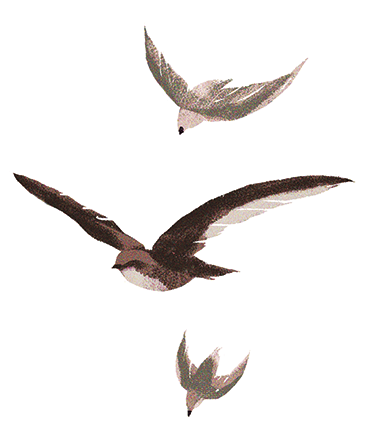
And then, as I was lying on my back, they were suddenly there.
“Why are you crying, Daddy?” said Rachel, who was watching my face instead of the sky.
“Because it’s all right,” I said. “Because the world still works.”
“Okay,” she said.
They’re always suddenly there or suddenly not there.
The air crawls. Up there, like plankton, there are live things drifting in the wind; aphids, other bugs, spiders, beetles. An aphid might be sucked from a grass stem in an English wood, up a gurgling plughole in the air, across the Pyrenees and the Strait of Gibraltar, and into the crop of a zitting cisticola at an oasis in Mauritania.
I’ve tried to map the vortices. It’s best done from quite tall, bald trees with lots of footholds on which you can stand at many heights. It’s a happy, mesmeric way to pass the day.
Airborne thistledown’s the best marker of the vortices. It probably doesn’t weigh much more than an aphid. Near the ground the thistledown is tentative. It moves from side to side, as if testing the worth of all the possible air channels. By four feet up it has decided where to go, though a fleck of down that started in the same flower head might well have chosen differently.
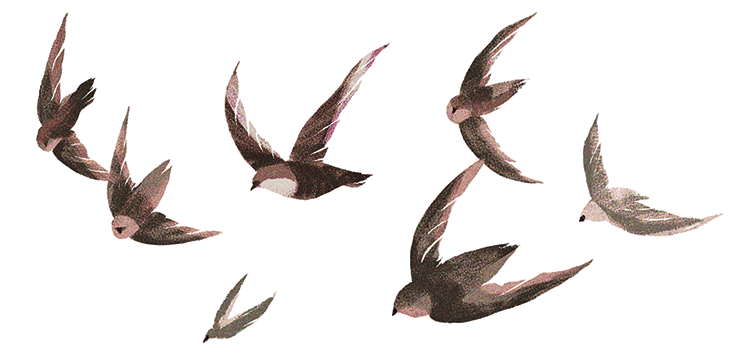
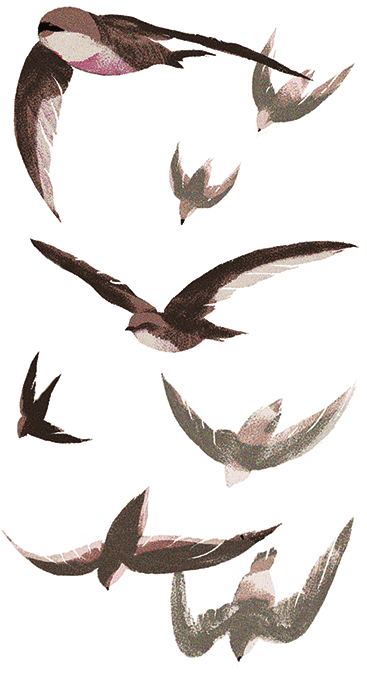
In a wood, or above a field, the vortices are an unseen forest of tangled chimneys. The chimney walls are quite hard. Not much escapes from them. They’re often very close together, but they’re rarely exactly parallel, and they sometimes even cross. Each has a tight centripetal glug, but they don’t just channel straight up. Each has tides and eddies. Bugs and seeds bounce off one another and off the walls: They somersault and arabesque. An aphid that almost made it out beyond the canopy might be blown back down by the fat cheeks of the summer and pass one coming up that started its climb from the undergrowth an hour before.
At the top of the tree line there’s a tangled delta. The chimneys swell, start to knot, and disgorge into a flat bowl that spins them together. The flotsam gathers pace; the streams are wider and denser.
The swifts graze the streams. Perhaps there’s another delta and another flattening farther up. Certainly by an altitude of a hundred yards or so the pickings are thin. Yet swifts are often very much higher than this, where they’re unlikely to be feeding.
It’s different in open country. There the sun sucks up the earth hard. Banks of wind surf roll across the land, hit a wall, a ditch, or a ripple, and surge up, becoming mushrooms. The stalks of air are huge writhing rivers of tiny spiders and aphids, sometimes hundreds of yards wide, racing in tumbling spate from the fields to the high clouds. They rasp a hand plunged into them.
The summer sky is, usually, a rigidly stratified bird sandwich. The swifts feed at the top; the martins are below them, and swallows wobble the top of the grass with their wake. But the swifts sometimes slice down into the martins’ patch, and when the sky is heavy with wet electric power, they’re pushed farther down among the swallows to the fields and the lakes.
I was once in the middle of one of these kill orgies.
Swifts are selective, fastidious feeders. Although they catch 5,000 or more insects a day, and though they have wide gapes like the mouth of a trawl net, they don’t usually trawl. They go for the big, stingless insects. You can see them swing off their course to get them. And their discrimination is nuanced. When they hunt bees they take the stingless drones selectively. Try telling drones from workers at a speed of 50 feet a second. And they’re not just responding crudely to insect warning livery: They take plenty of stingless bee and wasp mimics. We don’t know how they tell the difference, but it must be visual.
They are hunters—aerial sight hounds—snapping like terriers, and so they have two foveas: a shallow monocular one, and a deep magnifying one. This deep device probably gives them some binocular vision, used for computing the distance of speedy insects. They’re like cheetahs or peregrines. When a swift first spots a likely kill, it’ll be at a similar distance from it, relative to the size of the prey, as a peregrine would be from a pigeon, a cheetah from a Thomson’s gazelle, or I from a deer far across the hill. Identical visuospatial problems have to be solved in each case. Like a peregrine, the swift will nod its head as it bears down, switching between devices—between the big picture and the detail. Both are needed for an efficient kill that won’t leave a sting in the mouth.
Though they’re mainly trophy hunters in the sky plains, swifts are not above a gulping, glutting feeding frenzy if the chimneys are serving up a fresh hatch.
I was once in the middle of one of these kill orgies. I was dragging a very small child along to day care to be contained for a while, when the air above a wood by the road exploded in black, screeching sparks. The swifts were among a new hatch rising from the treetops; not bothering with hairpin turns, just plowing through, jerking openmouthed heads from side to side to hit the areas of deepest density.
I told the 3-year-old to wait in the stinging nettles, ran across the road, and scrambled up a tree as high as I could get. That was quite high. I swayed in a fork just below the top and pushed my head out into the killing zone of the delta.
I saw a tongue, squat, gray, and dry; I saw myself, pinched and saucer-eyed. I felt the cool electric grace of a downstroke on my face. I snapped a mouthful of nymphs and spat them onto the roof of a brand new Mercedes dropping off a child from a house 300 yards away.
It was the closest I ever got.
But becoming a swift? I might as well try to be God.
I strapped myself into a harness and was tugged by a parachute into the sky. It taught me the taste of height—but the taste to a palate designed for 6 feet above the earth, not 6,000. It taught me about the roar of the wind, but the roar in flapping ears fixed on the sides of a big crude block of a head, forced under a gushing tap. It didn’t teach me how the temperature changed as I climbed: My face was too flushed with fear and thought to notice, and the rest of my body was wrapped in wool and nylon.
Swifts feel the ground by the shape of the breath it exhales.
They smell their way through the scent columns. They hunt in a reflected image of the earth—an image as dense and sticky as a caramel apple.
I followed the swifts with my eyes, despairing as they climbed up to roost in the air.
I looked down at woods and fields and saw woods and fields. For a swift, woods and fields are pizza delivery joints. You never go to one of those. You just call and speak to a disembodied voice. You don’t really have much of a picture of what’s there. You’ve never thought about it. You probably know vaguely where it is. If pressed, you might use its location as part of a set of directions to somewhere else (as a swift may use some terrestrial signposts for navigation). But it has no intrinsic interest other than as the source of your pizza. The swift stays at home in the air, and the earth delivers.
It’s not surprising that poets get all ethereal about swifts. If anything can be literally ethereal, swifts are.
The main problem with turning myself into a swift, though, isn’t that it’s an air thing and I’m a soil thing. It’s speed. I’m a terribly slow animal. The difference between our relative perceptions of the texture of the air is vast, but it’s as nothing compared to the difference in pace of our lives.
In terms of longevity, a swift is comparable to many humans. Swifts have been known to live to 21. It’s the amount of living that they put into each of the years that’s the real difference.
Some arithmetic, because there is a type of truth in figures:
Each spring and each autumn they travel around 5,592 miles between Oxford and the Congo: That’s 11,184 miles every year—which doesn’t begin to account for the flying that they do in their ordinary lives. That’s spread over about 66 days in the autumn (30 days of traveling, 36 days of stopover) and 26 days in the spring (21 days of traveling and 5 days of stopover). In autumn they average around 186 miles per day toward the 5,592 miles), and in the spring 266 miles per day. Let’s assume that on the migration stopovers they do 47 miles a day feeding, soaring, sleeping, and exulting. Let’s say that in the rest of their lives they’re doing 62 miles a day.
The balance sheet therefore looks like this:
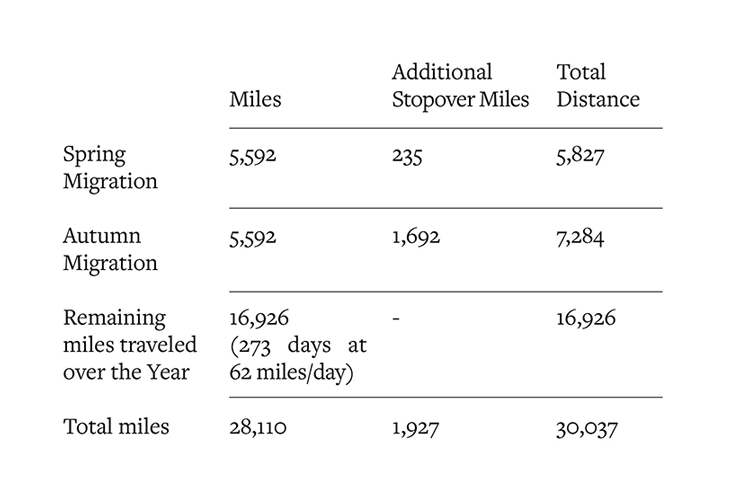
For 21 years that’s 630,777 miles—about 1/150th the distance between the earth and the sun and 2.6 times the distance between the earth and the moon.
Swifts are about 6.5 inches long. I’m about 6 feet—about 11 times the length. If I were to walk proportionately as far in 21 years, I’d have walked almost 1/13 of the way to the sun, or 29 times to the moon. If I kept up the same pace and lived to 84—a realistic equivalent for that long-lived swift—I’d have walked almost a third of the way to the sun and 116 times to the moon.
But it’s not all traveling and killing (though think of the millions of individual, assessed, intimately targeted head turns and snaps there will have been). That 21-year-old may well have bred 19 times. The average number of nestlings might be as high as 1.7 per season. That’s 32 in its breeding lifetime. Multiply that by four for me: 128.
That’s what they do with their time. But what about their perception of what they’re doing? If (and yes, it’s a big if ) they’re watching, as we do, a film of their own lives, how fast is it moving? And how frantic are those snapping heads?
If those questions mean anything at all, they must relate in some way, however crudely, to the speed of perception.
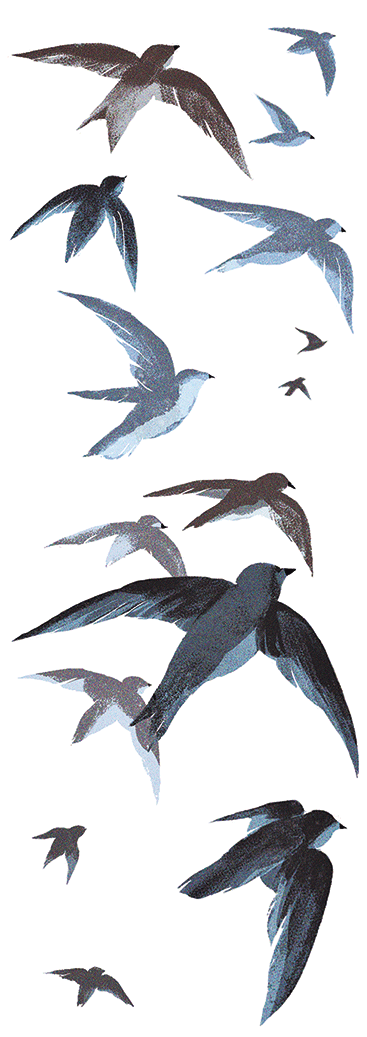
Snails move very, very slowly. Only if events are more than a quarter of a second apart will a snail perceive them as distinct. If you wave your finger in front of a snail four times or more a second, it will see a single, stationary finger. Sloth freezes movement: it blurs, simplifies, and integrates, and in integrating it loses a lot of the whole. It obscures the distinct parts of things, if time is an element of those parts, and concocts the lie that it sees things as they really are. It drains time out of our vision. Oversimplification is deceit.
Whereas speed, if you’re up to it, can tell you the value of time; can let you see your business with the due contribution from time’s perspective; can inject complexity and nuance. If, like some birds, you can hear sounds separated by less than two-millionths of a second, you’ll know the baroque complexity of apparently bland birdsong. If you’re a human hearing that, you’ll fall on your knees. Wonder is a function of the degree of resolution—in birdsong, in optics, in philosophy, in theology. Only those blind to the velvet flow of a caterpillar’s legs and deaf to the grunt of a crocus as it noses out of the earth don’t worship, and often they can’t be blamed.
Another way of putting this is that really fast hardware and software can effectively slow down the world. The acutely discriminating bird hears what I’d hear if I turned the speed of the birdsong right down. I can probably hear two sounds as distinct if they’re around two-hundredths of a second apart. The bird’s getting in one second what it would take me about two and three-quarters of an hour to hear. If the rest of the bird’s tape runs at a similar rate, and the bird (let’s call it a swift) lives for 21 years, then, since it has done 10,000 times as much living per unit time as I have, it will die at a real age of 210,000 years—the distance separating us from the time when the first modern humans evolved in East Africa.
Now let’s try this with physical speed—which of course entails a lot of attention in many different neurological modalities. The snail can get by as a woefully crude visual discriminator because it moves over ground at a top speed of about a yard an hour.
The highest migration speed recorded for swifts over a long distance is (a plainly wind-assisted) 404 miles per day. The average for the spring migration is 209 miles per day. Measured by tracking radar, the flight speed of swifts on spring migration was 35 feet per second, which, if maintained over 24 hours, would be 573 miles per day. The fastest human runner, Usain Bolt, clocked 34 feet per second over 328 feet (a hundred 100 meters). Then he stopped, panted, was wrapped in a blanket, handed an energy drink, and carried shoulder-high around the stadium. The swifts continue, at about the same pace, 3,483 times farther per day, for the best part of a month, catching their own food and navigating across deserts, seas, and mountains. We, at our very best, are snails.
Of course there are obvious objections to all these nerdishly arithmetical types of comparison. I’ve been making them myself as I’ve tapped away. I agree with them all. But even if the comparisons are wholly worthless, it’s worth making them in order to demonstrate their worthlessness, and so clear the ground for something else.
The figures might be the grammar of swifts. Grammar is necessary but not sufficient for poetry. I’ve tried to be prosaic, because when it comes to swifts, all poetry fails.
I can’t follow the swifts into the air. I’m less like them there than when I’m on the ground. Planes, of course, aren’t about the air at all. You’re furthest from swifts in a hurtling tube full of flatus. The view’s disembodiedly cartographical.
The air, for me, is necessarily about buckles and ball-crunching harness. I lurch, swing, and churn. At best I’m a huge aphid—a drifting piece of swift-food. At least on the ground I can dodge and roll for whole seconds at a time, and on a mountain path in a gale I can feel secure when wind is blowing around me at the same speed as around the head of a migrating swift. If I strip off my clothes on the path I’ll get feedback from my ruffled body hair that’s not all that unlike the tingling from the touch receptors of the swift’s filo-plumes—minute, hairlike feathers that lie alongside the contour feathers, moving with them and letting mission control know where each of the big plumes is in space.
I’m best at being a swift when I’m on the ground.
Water’s better, I suppose, but still remote. There I’m as buoyant as the swift when it’s sleeping 2 miles above the sea. My legs could be its forked tail: they do the same job. I can angle my arms like its saber wings, and they take me down or up. But the water takes away almost as much of the swift-life as it gives. It takes away speed, and therefore swift time. A slow swift is perhaps even less of a swift than a stiff swift.
I’m best at being a swift when I’m on the ground. At least then I can see and smell the source of the air rivers the swifts are fishing, hear the thrum next to my ear of the wasp that will be broken 300 yards up, and slap a fly on my arm at more or less the same speed as the swift’s stubby neck will turn and its mandibles close on it.
Sitting on a bench in my Oxford garden, I followed the swifts with my eyes, despairing as they climbed up to roost in the air, beyond all eyesight, beyond all sense, sensibility, and words.
When they left I couldn’t bear it. I followed them across the Channel and across France, noting down slavishly—like a bereaved disciple looking for relics—the things that the swifts might have seen or smelled or heard as they came this way. It seemed to matter that the smell of a Picardy bonfire was rendered properly in the notebooks: The birds might have caught beetles that the fire hoisted into a cloud. The chatter in a Pyrenean café was relevant: The same phrases were likely to have been used a fortnight before, at the same volumes, and at the same tables, and so to have ricocheted off the same mildewed whitewash and up into the air over the mountain at the same angles, contributing to the same hum and throb that the swifts knew, and giving a floating aphid the same sort of jerk that caused a swift’s head to turn. The wine that night in an Andalusian courtyard had to be described exactly because nitrate from swift dung might have coursed into the grapes, and because insects that fed on the vines might have spiraled up in a fog of lemons and rotting shrimp and been taken by you know what. Or you know who.
The world was a web, fine as gauze, woven of causes—each cause connected to the others, and each traceable ultimately, if you followed things carefully, to the swifts.
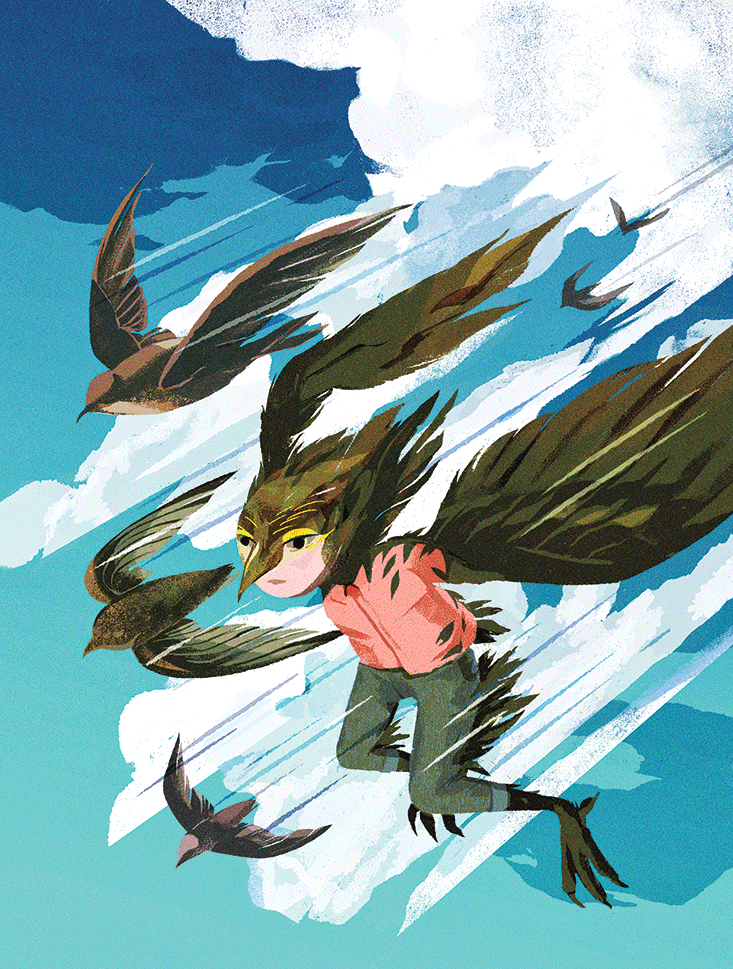
Charles Foster is a Fellow of Green Templeton College at the University of Oxford, and has written on travel, science, and philosophy.
Excerpted from Being a Beast: Adventures Across the Species Divide by Charles Foster, published by Metropolitan Books, an imprint of Henry Holt and Company, LLC. Copyright © 2016 by Charles Foster. All rights reserved.






























